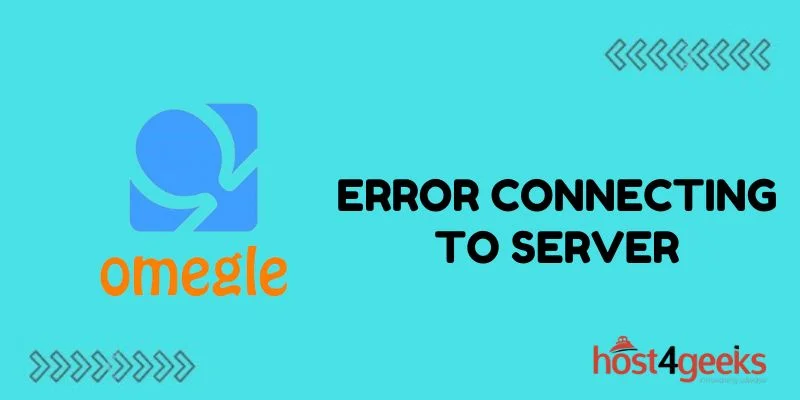Omegle is a popular platform for anonymous video chatting that randomly pairs users in one-on-one conversations. However, many users encounter the frustrating “Error Connecting to Server” message which prevents getting matched and disrupts the site’s core functionality.
This common error stems from issues like internet instability, high traffic overloading servers, IP bans, outdated clients causing conflicts, or even full Omegle server outages.
By diagnosing the specific trigger and applying focused troubleshooting, users can resolve or work around the message to restore chatting access. We’ll examine the key reasons for the error appearing, solutions for each cause, and preventative measures.
Underlying Reasons Behind the Message
Unstable Internet Connectivity
Before assuming the issue lies with Omegle’s servers, first, check that your own internet connection is strong and consistent enough to maintain server communications.
Run a broadband speed test during the error to confirm your available bandwidth isn’t dropping. Also, try loading other sites alongside Omegle failures to isolate problems.
Intermittent router or modem connectivity, WiFi signal drops, ISP service impacts, or general conflicts can all influence connectivity stability. Typically other sites will also struggle with loading amidst broader internet shortfalls.
Traffic Spikes Overwhelming Servers
During peak hours with heavy user volumes, Omegle’s servers can hit capacity choking points struggling to handle so many simultaneous chat requests.
Limited resources spread too thin across large waves of visitors flood the servers and prevent properly pairing users, producing connectivity errors.
The failures specifically arise at peak traffic moments then may resolve hours later once visitor counts and chat demand drops back down within normal server load limits.
Blocked IP Addresses Through Bans
Automated systems monitor Omegle network activity for spammers, harassing users, or terms of service violations based on IP addresses. Per a ban, they block any further requests from reaching web chat servers.
Banned devices endlessly receive connectivity errors. Omegle lacks an appeals system so you must first determine if an active IP restriction causes the message before solving it.
Software & Browser Incompatibility
On the client side, using outdated Omegle mobile apps or desktop browser software often spurs conflicts reaching servers. Missing key updates on the servers may now depend on triggers version mismatch issues.
Particularly on browsers, needed cookies, cached data or new security requirements rely on current software. Failure to upgrade prevents proper handshakes between your device and Omegle’s systems.
Omegle Server Outages
Despite best efforts, full outages occasionally disrupt even top-tier sites and Omegle is no exception. Heavy traffic loads paired with a server software glitch cause general connectivity failures that users first discover through error messages.
But in these large scale underlying issues, the problem exists solely on Omegle’s end rather than on user devices. Checking their server update page confirms site-wide downtime.
Troubleshooting Each Error Cause
With many potential sources, targeted troubleshooting determines the true catalyst behind connectivity errors:
Check Connectivity Strength
First, confirm internet bandwidth availability hasn’t changed and that other sites remain accessible during Omegle server errors.
Compare against a working state to see if limited connectivity affects the wider web versus just Omegle. Run speed tests across devices using WiFi versus mobile data.
Use a VPN or Proxy to Bypass IP Bans
If internet access seems otherwise reliable, use a VPN browser extension or proxy site to mask your device’s IP address. This provides an alternate unrestricted identifier that Omegle systems recognize.
Many top services offer free VPNs perfect for bypassing location or IP targeting. Switch countries to maximize effectiveness in case certain regions face blocks.
Update Software and clear Browser Cache
Mobile apps readily self-update via Android or Apple stores. For desktop browsers, manually install the latest release versions clearing all temporary data and cookies after upgrading.
This provides a clean slate for Omegle to reimplement any required data to your new browser version speaking correctly to their systems.
Compare During Peak & Off Hours
Since high traffic overload hampers servers the most, test throughout the day and night to isolate it as the cause if chat functions properly during off-peak periods.
Early morning and late evening typically see lower visitor counts. If those time windows allow smooth access minus connectivity errors, server strain is likely the culprit.
Check Omegle Server Statuses
When all user-side troubleshooting still results in errors, reference Omegle’s server update page noting any acknowledged widespread issues specifically calling out dropped connections, chat problems, or total outages.
If they report an ongoing incident, only patience resolves it versus tackling device settings and software workarounds.
Preventing Connectivity Errors
Once you restore the server communicating through the above steps, supplementary precautions minimize future issues:
- Verify Omegle mobile app updates automatically or trigger manually in stores
- Enable auto browser upgrading on desktops so they remain supported
- Bookmark Omegle’s status page to quickly reference during errors
- Note peak traffic hours producing more messages and test other periods
- Record reliable VPN services and proxies to rotate as needed
With attentive connectivity monitoring, staying updated, and confirming server-side issues, the “Error Connecting to Server” message doesn’t have to halt Omegle usage. Quick diagnosis of the specific cause allows fixing your access in minutes.
In summary
In closing, while frustrating, the root triggers behind Omegle’s “Error Connecting to Server” messages prove manageable with selective troubleshooting. Confirming internet stability on the user side rules out local outages. Utilizing VPN workarounds bypasses restrictive IP bans if still occur.
Software and browser updating eliminates version mismatch conflicts and caching problems with Omegle’s servers. Monitoring peak traffic periods and overall server statuses pinpoints wider disruptions as well.
Through systematic elimination of potential issues in connectivity, IP blocks, client-side apps, and site infrastructure, users can swiftly resolve the errors and resume Omegle’s anonymous video chatting capabilities with optimal reliability. Staying vigilant on updates and performance testing keeps further failures at bay.
